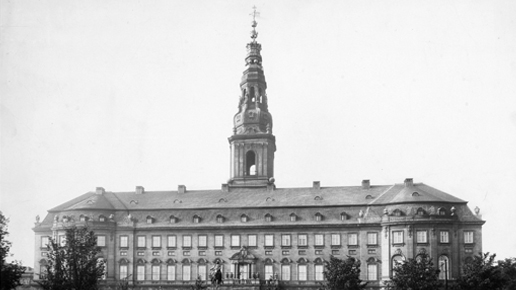
The issue of rebuilding Christiansborg Palace is taken up in 1901 when, in the wake of many years of constitutional wrangling, negative parliamentarism is introduced in Denmark. This means that a government cannot be inaugurated or persist if it has a majority against it. The story of palace reconstruction therefore also describes the traumas of Denmark’s infant democracy.
From 1906 until 1928, architect Thorvald Jørgensen is commissioned to build the current (Third) Christiansborg Palace on the foundations of the previous two palaces:
- In 1918, Rigsdagen moves into the Rigsdag’s Wing.
- In 1919, the Supreme Court rooms are ready.
- The palace is finally complete in 1928.
Imposing architecture reflects a strong sense of power
The palace is built in the Neo-baroque style. The solidity of the building emphasises the importance of the palace as Denmark’s political fulcrum.
The architect decorates the façades with symbols that reflect the palace’s status as the stronghold of Danish democracy. The lower parts of the walls are clad with granite from every municipality in the country and Greenland. The only exception is Prins Jørgens Gård (Prince George’s Square) which is faced with sandstone salvaged from the Second Christiansborg Palace. Sandstone figures crowning the windows depict the coats of arms of Danish towns and shires and the faces of famous Danish politicians.
The Upper and Lower Chambers are different
Architect Thorvald Jørgensen is involved in every phase of the construction of today’s Christiansborg Palace. He also designs the interiors and furnishings, including even inkwells and pen stands.
Folketinget (then the Lower Chamber) is a body mainly of farmers, merchants and educated citizens. The Lower Chamber is fitted with dark oak panelling, echoing bourgeois taste.
The white baroque Upper Chamber is appointed in a style typical of a manorial hall and its design reflects that the members of the Upper Chamber are wealthy landowners and civil servants.
Royal Palace and Seat of Parliament
The Royal family initially intends to live at the palace so the architect Thorvald Jørgensen divides it into two distinct parts: the west wing facing Holmens Canal is appointed as a 95-room royal residence and the east wing facing the harbour is furnished to accommodate the politicians.
In 1920, King Christian X has a change of thought. He wishes to remain at Amalienborg Palace where the royal family has resided since 1794. Instead, the Danish Ministry of Foreign Affairs moves into the west wing. The Danish Parliament acquires this part of the palace in 1980 while apartments on the second floor of the north wing of the palace – the corner facing the Royal Stables – become the Prime Minister’s Office.
The original royal wing facing the Grand Square now houses parliamentary committee rooms. The Prime Minister meets the press in the Hall of Mirrors, which was originally intended to be the king’s dining room.
The regent still has some of the west wing of the palace at her disposal. These are the Royal Reception Rooms, including the Throne Room.
Christiansborg Palace burns again
The present Christiansborg Palace has stood for almost 100 years. Like its predecessors, it has been dogged by fire.
1992 is a disastrous year for the palace. During an extensive restoration project, fire breaks out in the Warehouse attic. Restoration work is therefore already delayed when a firework sets the Palace Church alight during Copenhagen Carnival. Restoration work is completed and the church in use again in 1997.